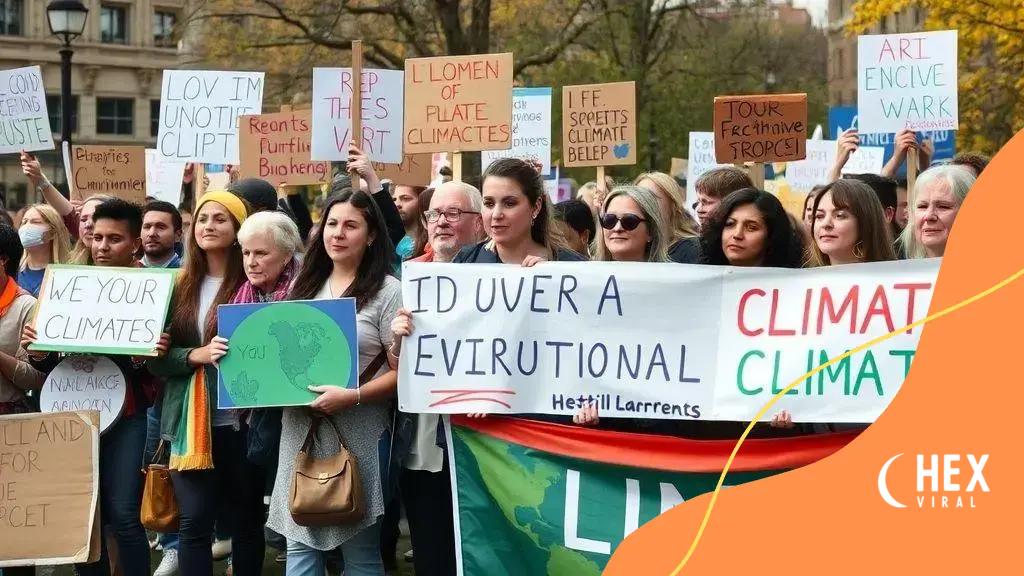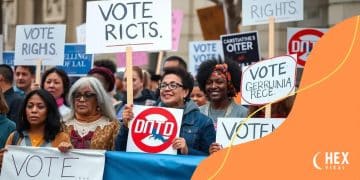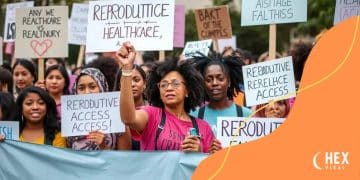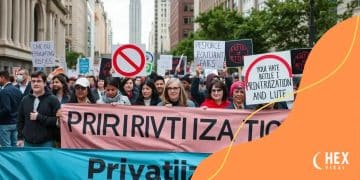Climate protest coverage: what you need to know now

Climate protest coverage is crucial for understanding the impact of activism on policy, media representation, and societal engagement, while ensuring safety measures allows for a more effective demonstration of demands for urgent climate action.
Climate protest coverage plays a vital role in shaping public perception and policy. As awareness of climate issues grows, protests become a key avenue for voices advocating for change. What trends are emerging in these movements?
The evolution of climate protests
The evolution of climate protests showcases how communities around the world have come together to advocate for urgent action against climate change. These movements have transformed over the years, driven by a growing awareness of environmental issues and the need for immediate solutions.
Historical Context
To understand today’s climate protests, it’s essential to consider their origins. Early initiatives, often limited to local awareness campaigns, laid the groundwork for more extensive global movements. The first major protests emerged in the late 20th century, led by passionate activists who aimed to raise awareness about the impacts of pollution and dwindling natural resources.
Rise of Global Movements
As concerns regarding climate change intensified, so did the scale of protests. The 2010s saw the rise of significant international movements, such as Fridays for Future and Extinction Rebellion. These groups leveraged social media to connect individuals and spread their messages globally.
- Fridays for Future focuses on youth-led demonstrations.
- Extinction Rebellion emphasizes nonviolent resistance to highlight the climate crisis.
- Both movements have sparked engaging public discussions about climate policies.
Individuals from various backgrounds participate in these protests, uniting under a common goal. The increase in participation demonstrates that climate activism resonates deeply across generations. The presence of schools, universities, and local organizations amplifies these voices, making them heard worldwide.
Current Trends
Current trends in climate protests reflect a more organized approach. Activists are now focusing on specific issues, such as fossil fuel subsidies, deforestation, and environmental justice. They are also collaborating with scientists, policymakers, and celebrities to push their agendas even further.
Community involvement is at an all-time high, and many protests now feature educational components. Workshops, speeches, and artistic performances promote awareness and encourage individuals to take actionable steps in their own lives. Every protest is not just a demonstration but a platform for community building and education.
Ultimately, the evolution of climate protests signifies a growing recognition of the climate emergency. As these movements continue to expand, the message surrounding climate action becomes clearer: urgent changes are needed to ensure a sustainable future for all.
Key figures in climate activism
Understanding the impact of key figures in climate activism provides insights into how movements gain momentum. These individuals play a significant role in shaping public opinion and guiding actions in the fight for climate justice.
Influential Activists
Many activists have emerged as prominent voices in recent years. They use their platforms to advocate for change and mobilize support. One of the most notable figures is Greta Thunberg, whose passionate speeches have inspired millions worldwide. Another important figure is David Attenborough, whose documentaries have raised awareness about environmental issues.
- Greta Thunberg emphasizes the urgency of climate action.
- David Attenborough provides compelling visual narratives on the natural world.
- Jane Goodall focuses on the connection between climate and wildlife conservation.
These activists bring diverse perspectives and experiences to the climate movement. Their unique approaches resonate with various audiences, helping to broaden the reach of their messages.
Youth Involvement
Young activists are increasingly influencing climate discourse. Groups like the Sunrise Movement are composed mainly of young people, advocating for policies that address climate change and promote equity. They emphasize the need for a sustainable future and represent the voices of a generation that will inherit the planet’s challenges.
Their involvement highlights a key aspect of climate activism: inclusivity. The movement encourages individuals of all ages to get involved and make their voices heard. Many are inspired by their peers, leading to a ripple effect of activism across schools and communities.
The contributions of these key figures emphasize the importance of collaboration in the fight against climate change. By working together, activists can build coalitions and amplify their impact on local and global scales.
Impact of media on climate protest visibility

The impact of media on climate protest visibility is profound. Media coverage can amplify messages and increase public awareness about climate issues. In today’s fast-paced world, the way information is shared can significantly affect how audiences perceive climate activism.
Role of Traditional Media
Traditional media outlets like newspapers, television, and radio have historically played a key role in shaping public discourse. Coverage of climate protests can highlight urgent issues and influence policymaking. Major news outlets often feature reports on high-profile events, which can result in larger audiences learning about the climate crisis.
- Coverage of protests brings visibility to activists and their demands.
- In-depth reporting can educate the public on climate science and policy.
- Interviews with activists help personalize the movement, making it relatable to viewers.
When traditional media engages deeply with climate stories, it can mobilize communities and inspire action. However, without consistent coverage, many voices may remain unheard.
Influence of Social Media
Social media platforms like Twitter, Instagram, and Facebook have transformed the way information spreads. Activists can share real-time updates, photos, and videos from the ground, ensuring that events reach a global audience almost instantly. This grassroots approach allows for a diverse range of viewpoints to be shared, making climate issues more accessible and relatable.
Social media helps build strong online communities. Many users participate by sharing their own stories and experiences related to climate change, fostering solidarity among protestors. Viral campaigns often spark interest and encourage people to participate in protests, showing that anyone can make a difference.
Hashtags related to climate justice, such as #FridaysForFuture, significantly boost engagement. They allow people to join conversations and connect with like-minded individuals globally. The use of social media not only increases visibility but also democratizes the flow of information.
Overall, the combined effect of traditional and social media creates a multi-faceted approach to climate protest visibility. As media continues to evolve, its role in shaping narratives around climate activism is critical.
Safety measures during protests
Ensuring safety during climate protests is crucial for participants and organizers alike. Safety measures during protests help protect individuals while allowing them to express their views effectively. With growing participation in protests, awareness of safety protocols has become increasingly important.
Planning Ahead
Effective planning is the first step in ensuring safety at any protest. Organizers should clearly define the protest route, gather necessary permits, and communicate any potential risks to participants. Providing maps and information about safe meeting points can ease worries and empower attendees.
- Review local laws regarding protests to ensure compliance.
- Communicate emergency contacts to participants in advance.
- Establish clear guidelines for behavior and expectations during the event.
By planning ahead, organizers can anticipate challenges and create a safer environment for everyone involved.
Emergency Procedures
Having a plan for emergencies is essential. If conflicts arise, knowing how to respond can prevent escalation and keep everyone safe. Briefing participants about emergency procedures can be very helpful. This includes knowing where to go if someone feels threatened or needs immediate medical attention.
Safety teams, consisting of trained individuals, can monitor the crowd and handle any issues that may arise. They should always be easy to identify, perhaps wearing distinctive clothing or badges.
Additionally, first-aid kits should be readily available at all protests. These kits can provide immediate assistance for minor injuries, ensuring that people feel secure in attending.
Another essential aspect involves de-escalation techniques. Training selected individuals in conflict resolution can help maintain a peaceful environment throughout the protest.
Ultimately, maintaining a strong focus on safety measures helps build a positive atmosphere at climate protests. When individuals feel secure, they are more likely to engage actively in advocating for change.
Government responses to climate activism
Understanding government responses to climate activism is essential in today’s climate landscape. As protests gain visibility, governments face increasing pressure to address climate issues, which creates a complex interaction between activists and policymakers.
Policy Changes
Many governments have begun to respond to the demands made by climate activists. In several countries, this has resulted in new policies aimed at reducing carbon emissions and promoting renewable energy sources. For example, some nations have committed to net-zero emissions targets, recognizing the urgency of transitioning to sustainable practices.
- Implementation of stricter regulations on pollution.
- Investment in green technologies and infrastructure.
- Development of public transportation systems to reduce fossil fuel dependency.
These policy changes reflect a growing acknowledgment of climate change as a critical issue that requires immediate action. As public demonstrations continue, the need for transparent and accountable governance becomes increasingly important.
Engagement with Activists
Another way governments respond to climate activism is by engaging directly with activists. Some officials hold meetings with protest leaders to discuss their concerns, providing a platform for dialogue. This approach helps to foster understanding between the two sides.
However, responses can vary widely. In some cases, authorities may view protests as a threat, leading to crackdowns on demonstrations, which can escalate tensions. In other instances, governments may encourage participation from activists, recognizing their role in advocating for environmental protections.
It is crucial to monitor how these interactions shape future activism. Collaboration between activists and governments can lead to meaningful progress, while conflict may hinder the movement’s efforts.
Ultimately, the relationship between climate activism and government responses is dynamic. As public interest in climate issues grows, the pressure on governments to act will likely continue to intensify, requiring both sides to find ways to work together effectively.
FAQ – Frequently Asked Questions about Climate Protests
What are climate protests?
Climate protests are public demonstrations advocating for action against climate change and environmental issues.
How do government responses to climate activism influence policy?
Government responses can lead to new policies aimed at reducing emissions and increasing support for renewable energy.
What role does media play in climate protests?
Media coverage amplifies the messages of activists, increases visibility, and informs the public about climate issues.
What safety measures should be in place during protests?
Safety measures include planning ahead, clear communication, having first-aid kits, and establishing emergency procedures.






